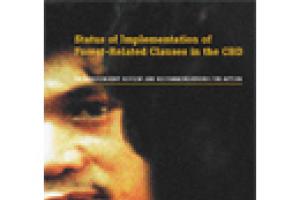On October 16, 2003, Irene Fernandez, the Director of Tenaganita (a women’s non-governmental organization based in Kuala Lumpur, Malaysia) was sentenced to 12 months imprisonment by the Magistrates Court for the Memorandum on "Abuse , Torture and Dehumanized Treatment of Migrant Workers in Detention Centres". The memorandum had been finalized and sent to relevant authorities and the media in August 1995.
Malaysia
Bulletin articles
12 February 2004
Other information
12 February 2004
This article highlights the vulnerability of dam-affected peoples -especially women- being displaced from their homes and lands, and relocated elsewhere. Due to the need to clear forests and divert the river, dams can effectively deprive those in the way of dams of rights to their traditional resources. It highlights some dam-related issues which are apparently shared the world over. But first some examples of on-going and completed dam projects in Malaysia, to show the price tag for 'development':
Bulletin articles
17 October 2003
Long Lunyim is a Penan community from Sungai Pelutan, Baram, located in the Miri Division of the state of Sarawak, Malaysia which used to be a part of another village called Long Tepen. The people of Long Lunyim decided some years ago to leave the village of Long Tepen and establish as a separate longhouse altogether slightly further away over disputes with the Long Tepen's headman on the encroachment of logging activities onto their customary land.
Bulletin articles
3 April 2003
Women are more than half --around 30.000-- of the workforce in Malaysian plantations, and have been historically employed as unskilled, temporary contract workers doing the most menial and underpaid jobs. Urbanisation and industrialisation has pushed men and the young to work in the new industrial zones while women stay on and continue to take on any job so that they can have a house and basic amenities provided by the plantation company, which are otherwise beyond their reach. Thus, women have played the dual role of providing cheap labour and social stability.
Bulletin articles
3 December 2002
Southeast Asian countries --particularly Indonesia and Malaysia--, have over 20 million hectares or 60 percent of the world's tropical peatlands. Peat swamps occur inland just beyond coastal mangroves and often spread over some 3km to 5km on the floodplain of rivers. They are characterised by an 8m to 20m thick layer of peat, which is mainly semi-decayed plant material accumulated over some 8,000 years. As long as the peaty soil is saturated with water, the swamp ecosystem is in balance.
Bulletin articles
14 May 2002
In the mid 1980s, the plight of the indigenous peoples of Sarawak got visibility when they staged peaceful protests against depletion of their home --the forest-- to logging activities or agroindustrial plantations for the benefit of commercial groups.
Bulletin articles
15 April 2002
Once again the indigenous peoples of Sarawak's rainforests are in the headlines. They have been long suffering and resisting encroachment in their ancestral lands by activities which on behalf of “progress” destroy their livelihoods and culture: logging, mining, oil palm plantations, pulpwood plantations, hydroelectric dams, resorts development (see WRM bulletins 41 and 43).
Other information
18 March 2002
Commissioned by the Global Forest Coalition
This report is based on 21 country case studies, including Australia, Brazil, Cameroon, Canada, Chile, Colombia, Czech republic, Ghana, India, Indonesia, Kenya,Malaysia, the Netherlands, New Zealand/Aotearoa, Papua New Guinea, Russia, South Africa, Suriname, Uganda, United Kingdom, and Uruguay
Bulletin articles
16 March 2002
The Penang Inshore Fishermen Welfare Association (PIFWA) has recently held a workshop on the importance of mangroves. Fisherfolk had there the opportunity to highlight what they already knew: that mangrove forest is an inherent part of their livelihood since it is closely related to fish catch. Without mangroves there will be no fish in the sea since they play a vital role as intermediaries between marine and terrestrial ecosystems.
Bulletin articles
20 February 2002
In national forest policy, forests usually refer to land and trees, which can include primary forests of native (indigenous) trees, forests of secondary growth and plantations of commercial trees cultivated by the state or private enterprises. Forests can also refer to trees planted for reforestation or soil conservation, after primary or secondary forests are logged. Forests are seen as containers of physical resources which are commodities for sale.
Bulletin articles
27 November 2001
Community map making has been an increasingly important tool for the indigenous communities in Sarawak. For people struggling to prove their land rights, the making of a map has been a necessary step in getting the boundaries of their lands recognised. In Sarawak, numerous NGOs have assisted communities in making maps of their village boundaries, which have then been used as evidence in court cases, as a resource management tool, and for many other purposes.
Bulletin articles
27 October 2001
The shrimp industry in Malaysia has developed rapidly since the early 1980s after the so-called successes experienced in neighbouring Thailand, Indonesia and Philippines. Malaysia, however, is not one of the major producers of cultured marine prawn in the world, as the area under marine prawn culture is about 5,100 hectares (2,627 hectares in 1995). Despite this, the Government of Malaysia is very proud to claim that the country's average production (metric tonnes per hectare) is the third highest in the world, after Taiwan and Thailand.

